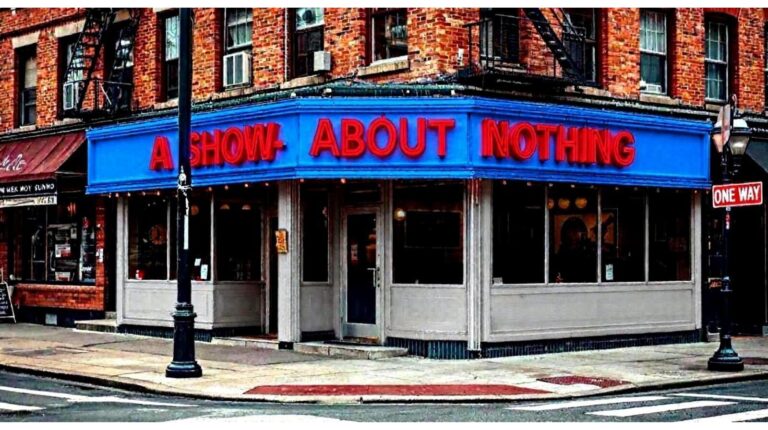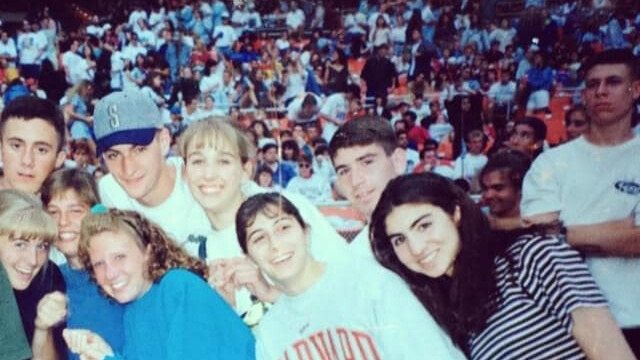Between 1992 and 1995, I spent more weekends than I can count folding tiny T-shirts at GapKids in Montgomery Mall in Bethesda, Maryland. It wasn’t glamorous, but working at the mall was its own rite of passage: equal parts paycheck, hangout spot, and backstage pass to the social hub of the ’90s.
The Mall as the Social Network of the ’90s
Before AOL chatrooms and AIM away messages, the mall was where everything happened. You didn’t just shop — you existed there. You wandered in packs with friends, scoped out who was working shifts, and made laps between The Disney Store, Sharper Image, Sbarro in the food court, and that one spot where everyone gathered. The mall was the internet before the internet, and its hallways were our feed.
The mall was a hangout spot in the ’90s. It was the Friday/Saturday default plan if there wasn’t something else going on, and often simply the go-to plan — whether friends window-shopped the corridors or actually had plans to nab the latest preppy combos at Britches Great Outdoors.

In earlier years (think: pre-driver’s license), going the mall was a hallmark of teen independence. That first taste of parent-free abandon. It was a couple floors and a dozen wings and hallways of solo-teen-ing with best friends.
For older teens, there was an element of “seeing and being seen” as in-real-life social currency back then, so what you wore, where you showed up, and who you were with mattered in the ways teens curate their Instagram profiles these days. There weren’t a ton of inexpensive ways for sixteen- and seventeen-year-olds to hang, outside of someone’s basement (which we did plenty of). The mall, however…
The mall delivered a climate-controlled, shopping-infused mecca, with copious amounts of cheap eats at the food court and miles of tile. Besides the obvious hangout spot, teens also had a ton of work opportunities at the mall. And, I was one of them.
Behind the Scenes at GapKids
When I was in high school working at GapKids, shifts typically ran in four-hour blocks right after school, with the occasional weekend thrown in. During the week, we clocked in around three o’clock, which left barely enough time to get out of school, cruise down I-270 Spur/I-495 S, and land in the Montgomery Mall parking lot.
It was a seven-mile drive that somehow took at least a half-hour, longer with rush hour, rubber-necking, or some other sort of Beltway chaos. That’s the D.C. suburbs for you.
Parking was part of the customer service training. We weren’t allowed to grab the easy spots close to the entrance — those were reserved for the people spending money, not the kids folding jeans. It was my first taste of what it meant to put the customer first, even before I walked through the glass doors.
Inside the store, that mindset continued. We were coached to ask open-ended questions: not, “Do you need help?” but “How can I help you?” or “What are you looking for today?” It made every shopper feel like the store was built for them, whether they were buying socks or stocking up on school clothes.
Then there was the rest of it … the everyday rhythm that made GapKids more than a job. Folding stacks of tiny jeans and reorganizing rainbow walls of tees might not sound glamorous, but it was a front-row seat to mall life.
Friends popped in “just to say hi,” music from the the Gap-curated mixtape looped endlessly from above — think Ace of Base, Lisa Loeb, and Seal on repeat — and every shift felt like a social hour disguised as work.
Every folded T-shirt came with a side of inside jokes and food court pizza.
The back room was where we’d hide during slow hours, taking turns restocking shelves, breaking down boxes, drinking an Orange Julius, and listening to our own mixtapes or WHFS on a boombox.
And yes, wielding a trusty plastic board, I learned to fold a shirt so perfectly it could have been framed. Every folded T-shirt came with a side of inside jokes, food-court pizza, and the kind of friendship that can only form under fluorescent lights and a steady stream of Seal’s “Kiss From a Rose.”
Working at GapKids wasn’t just about hanging clothes or cashing out customers, it was also my first real lesson in what it meant to represent a brand. From how we greeted shoppers to what we wore on the floor, every detail mattered.
Gap didn’t just sell jeans; it sold an image. And as employees, we were expected to be part of it — literally.
Brand standards: If you worked at GapKids, you wore Gap. Or at least the most neutral, logo-free basics you could find. Which, conveniently, led straight into one of the best perks of the job: the employee discount.

Employees were given discounts on clothing and other products across the gamut of Gap Inc. companies: Gap, GapKids, Banana Republic. In the 1990s, Old Navy wasn’t really a thing on the East Coast, but these days the Gap Inc. employee perks and benefits extend there, as well as Athleta.
Each month I’d get a select number of full price tops, bottoms, accessories, etc., for fifty percent off.
All the time, no matter the item, everything was thirty percent off, even the sale racks.
Couple those discounts with the fact that sixteen-year-old me could wear many of the GapKids styles in XXL or 16 (read: less expensive), and I built a pretty substantial closet full of Gap wear in the early- to mid-’90s.
If only I still had them…
Why Mall Jobs Were a Gen X Rite of Passage
For Gen X teens, a mall job wasn’t just a paycheck — it was independence. You learned to show up on time, deal with customers, and earn enough to cover gas money, weekend pizza, or maybe the latest CD. More than that, you belonged to a larger ecosystem. Working retail meant you were woven into the fabric of mall culture itself, a tiny cog in a buzzing, neon-lit machine.
In many ways, it was a real sense of independence and responsibility. Leveling up as a “key holder” who worked the registers at GapKids was a big deal at seventeen years old.
Did you know? By the mid-1990s, roughly one in five American teenagers worked in retail — most of us in shopping malls.
Paychecks were actual paper checks, and my six dollars an hour for a few four-hour shifts a week stretched pretty far back in the ’90s. Besides spending on clothes and mall “gets,” my money went towards gas, saving for vacation spending, the Metro, and hanging out at the Tastee Diner in Bethesda.
Back then, the mall was more than just a job site, it was our main stage. You could grab a slice, catch a movie, and maybe run into your crush all in the same hour. It was where every part of teenage life collided: work, friendship, music, and freedom, all under one roof. It’s no wonder mall jobs for Gen X teens felt like a shared cultural badge.
Today, most of those spaces are fading into nostalgia themselves, replaced by online shopping carts and digital “hangouts.” The mall’s role as a social hub has all but vanished, but for those of us who grew up behind the cash wraps and food court counters, it was the ultimate classroom for adulthood.
Maybe that’s why mall jobs feel almost mythic now. They were our first taste of real responsibility, sure — but also of belonging. Every folded sweater, every price check, every friend dropping by on a Friday night was part of a shared coming-of-age story that Gen X lived together, one mall shift at a time.
We all learned a little about money, fashion, and patience under fluorescent lights and Cinnabon sugar.
Why Mall Culture Still Resonates with Gen Z
The mall might not be the default Friday night plan anymore, but its spirit has never really left. Gen Z discovers it through TikToks of abandoned malls, reboots of shows set in the ’80s and ’90s, or the thrill of thrifting in food court-adjacent shops.
The mall is shorthand for a kind of community that feels rare now: a single place where music, fashion, food, and friends all collided. And that’s why it still resonates, even if today’s teens meet up more on Discord than at Orange Julius.
If you scroll TikTok or YouTube long enough, you’ll find whole communities dedicated to “dead mall” tours — walkthroughs of empty food courts and shuttered anchor stores that somehow feel sacred or liminal.
The fluorescent lighting, the echo of shoes on tile, the old signage half-lit by flickering bulbs. It’s not just voyeurism; it’s a kind of mourning for a shared social experience that’s disappearing.
Watch: Touring a “Dead Mall” — a Time Capsule of the ’90s
This short video captures the eerie charm of once-bustling mall corridors. They’re the same kind many of us wandered after school in the ’90s.
Video via YouTube: Abandoned Mall in St. Charles, Illinois.
Pop culture has noticed too. Stranger Things turned Starcourt Mall into a love letter to the ’80s, and Gen Z viewers devoured every neon sign and food court chase scene. To them, it’s a time capsule. To us, it’s memory. Either way, it’s proof that malls were more than architecture, they were the backdrop of coming-of-age.
And then there’s thrifting. Today’s teens scroll Depop and hit vintage shops with the same energy we brought to Goodwill racks in 1995. The thrill of finding something unique — a perfectly worn tee, a pair of retro Levi’s — is universal. The hunt connects our generations, even if the soundtrack swapped cassette hiss for a Spotify playlist.
What’s really at the heart of it all is connection. Malls were physical spaces that offered what social media promises but rarely delivers: spontaneous community. You could show up with no plan and still end up part of something … laughter echoing off glass, friends passing by, a quick bite at the food court. That feeling doesn’t age out. It just finds new spaces to live in.
The nostalgia endures because it isn’t just about shopping. It’s about belonging. For Gen X, mall jobs were where we learned about money, friendship, and responsibility long before Wi-Fi and smartphones rewrote the rules.






